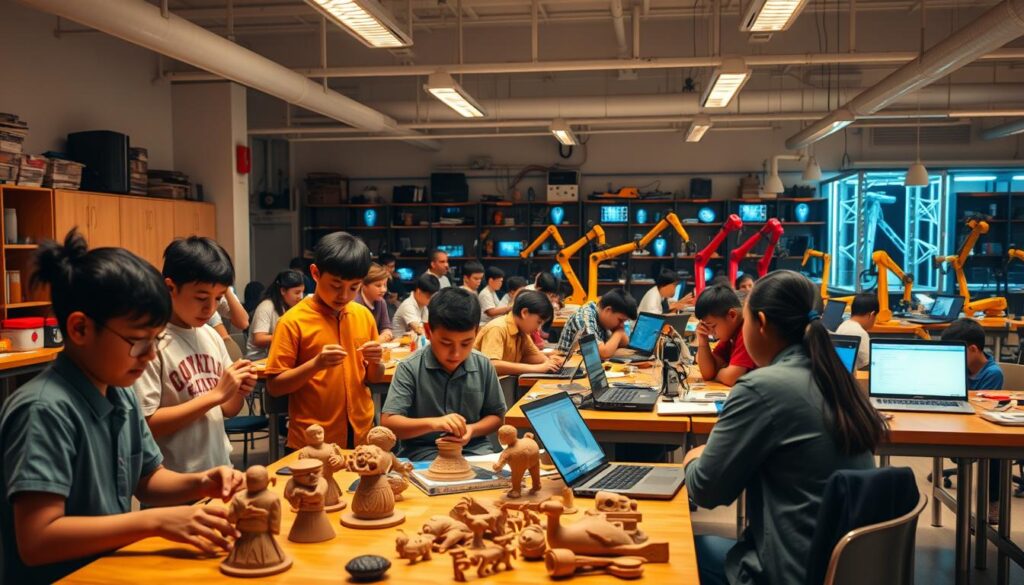Did you know that combining traditional indigenous knowledge with modern technology has shown great promise in tackling environmental challenges? From efforts to combine traditional irrigation techniques with modern technology to indigenous-led conservation efforts leveraging the latest tools, these unlikely cultural fusions are already contributing to the well-being of our planet.
The marriage of ancient techniques with modern technology is revolutionizing the way we address environmental issues. For instance, the PolArctic project combines local ecological knowledge with AI and satellite data to identify optimal areas for mariculture, helping to sustain the local ecosystem and economy, as highlighted in a recent article on indigenous sustainability trends.
Key Takeaways
- Combining traditional knowledge with modern technology can lead to innovative environmental solutions.
- Indigenous-led conservation efforts are leveraging modern tools to protect the environment.
- The integration of traditional and modern methods can improve environmental sustainability.
- Projects like PolArctic are successfully merging local ecological knowledge with modern technology.
- This fusion of traditional and modern approaches can have a positive impact on the environment and local economies.
Understanding Traditional Knowledge
At its core, traditional knowledge is about the intricate relationships between humans and their environment. This profound understanding has been developed over generations through close interaction with local ecosystems.
Definition and Importance
Traditional knowledge encompasses the practices, beliefs, and wisdom passed down through generations. It is characterized by a holistic approach, viewing humans as integral parts of the ecosystem. This knowledge is crucial for sustainable living and environmental conservation.
The importance of traditional knowledge lies in its ability to provide sustainable solutions to modern challenges. By understanding and respecting the natural world, communities have developed practices that ensure the long-term health of their environments.
Cultural Significance
Traditional knowledge is deeply rooted in the cultural heritage of communities worldwide. It reflects the unique relationship between a community and its environment, shaped by history, beliefs, and practices.
This cultural significance is evident in the diverse ways traditional knowledge is applied, from agriculture to architecture. Each community’s unique approach to interacting with its environment is a testament to the richness of traditional knowledge.
Examples in Various Cultures
Traditional knowledge is evident in various cultures around the world. For instance, indigenous communities have developed sophisticated irrigation systems that work in harmony with natural water cycles.
| Culture | Traditional Practice | Environmental Benefit |
|---|---|---|
| Indigenous Australian | Fire management | Prevents large-scale wildfires, promotes biodiversity |
| Native American | Crop rotation and polyculture | Enhances soil fertility, reduces pests and diseases |
| African | Terracing and soil conservation | Reduces soil erosion, improves water retention |
These examples highlight the value of traditional knowledge in promoting sustainable practices and environmental stewardship. By blending traditional and contemporary engineering, we can develop innovative solutions that respect the past while embracing the future.
The Role of Modern Engineering Techniques

Contemporary engineering has made significant strides in addressing environmental challenges. The field has evolved to incorporate a hybrid engineering approach, blending traditional knowledge with modern technology to create innovative solutions.
Overview of Contemporary Engineering
Modern engineering encompasses a broad range of disciplines, from civil and mechanical engineering to electrical and environmental engineering. It involves the application of scientific principles to design, build, and maintain structures, machines, and systems. The modernization of traditional knowledge is a key aspect of contemporary engineering, as it seeks to improve upon traditional practices with new technologies and materials.
Some of the key characteristics of contemporary engineering include:
- Innovative problem-solving
- Sustainable design practices
- Collaboration across disciplines
- Use of advanced technologies such as AI and IoT
Advances in Technology
Technological advancements have been a driving force behind the progress in modern engineering. The development of new materials, such as advanced composites and smart materials, has enabled the creation of more efficient and sustainable structures. Additionally, technologies like 3D printing and robotics have transformed the construction and manufacturing processes.
For instance, the use of renewable energy technologies has been a significant breakthrough. However, as noted in a study available at this link, the environmental impact of transporting solar panels is a factor that needs consideration.
Importance of Sustainable Practices
Sustainability is a critical aspect of modern engineering. As the world grapples with climate change and environmental degradation, engineers are tasked with developing solutions that minimize environmental impact. Sustainable practices in engineering include the use of renewable energy sources, reducing waste, and designing systems that are resilient and adaptable.
The importance of sustainable practices is highlighted in various initiatives worldwide, such as those discussed on this platform, which showcases engineering innovations for communities.
Some key sustainable practices in modern engineering include:
- Designing for energy efficiency
- Using recycled and recyclable materials
- Implementing waste reduction strategies
- Developing infrastructure that is resilient to natural disasters
Bridging the Gap Between Traditional and Modern
By combining ancient wisdom with contemporary methods, we can unlock new potentials in various fields. The integration of traditional knowledge with modern engineering techniques is creating new opportunities for sustainable development.
Benefits of Integration
The fusion of traditional and modern practices brings numerous benefits. For instance, enhanced Andean farming techniques are being integrated with modern irrigation systems to boost productivity and sustainability. This blend of old and new methods not only improves crop yields but also promotes environmental stewardship.
Some of the key benefits include:
- Increased efficiency through the use of modern technology
- Improved sustainability by incorporating traditional ecological knowledge
- Enhanced innovation through the combination of different knowledge systems
Challenges in Combination
Despite the benefits, there are challenges to combining traditional and modern practices. One of the main hurdles is the cultural and technological gap between the two approaches. For example, traditional knowledge is often passed down through generations orally, while modern engineering relies heavily on written documentation and technological tools.
| Challenge | Description | Potential Solution |
|---|---|---|
| Cultural Differences | Differences in cultural values and practices | Cultural sensitivity training for engineers |
| Technological Gap | Difference in technology used in traditional and modern practices | Gradual introduction of modern technology to traditional practitioners |
| Knowledge Transfer | Difficulty in transferring traditional knowledge to modern contexts | Documentation and standardization of traditional knowledge |
Collaboration Opportunities
Collaboration between traditional knowledge holders and modern engineers is crucial for successful integration. According to a study published in WJBPHS-2024-0850, collaborative projects have shown significant improvements in sustainability and innovation.
Some opportunities for collaboration include:
- Joint research projects to develop new sustainable technologies
- Workshops and training programs to facilitate knowledge exchange
- Community-based projects that integrate traditional and modern practices
The future of sustainable development lies in our ability to bridge the gap between traditional and modern practices. By working together and embracing the strengths of both approaches, we can create a more sustainable and equitable world.
Case Studies of Successful Integration

By merging traditional practices with cutting-edge engineering strategies, communities have achieved remarkable results. This integration has led to innovative solutions in various fields, including architecture, agriculture, and water management.
Indigenous Approaches in Architecture
Indigenous communities have developed unique architectural styles that are adapted to their local environments. For example, the Aztec floating gardens, known as ‘chinampas’, are an innovative example of traditional knowledge being used to create productive agricultural land in challenging environments. Similarly, the Coast Salish people of the Pacific Northwest have maintained clam gardens, which are intertidal habitats managed to increase shellfish productivity.
These traditional architectural practices not only demonstrate a deep understanding of local ecosystems but also provide valuable lessons for modern engineers. By studying these approaches, we can develop more sustainable and effective solutions. For more information on sustainable construction practices, you can refer to our guide on cutting construction costs in Africa.
Traditional Agricultural Techniques
Traditional agricultural techniques have been used for centuries to maintain soil fertility, conserve water, and promote biodiversity. For instance, the terracing techniques used by the Inca civilization in the Andean regions allowed for efficient irrigation and soil conservation, enabling agriculture in challenging mountainous terrain.
These traditional techniques can be combined with modern engineering to develop more sustainable agricultural practices. By integrating traditional knowledge with contemporary methods, we can improve crop yields, reduce environmental impact, and enhance food security.
Water Management Systems
Effective water management is crucial for communities worldwide. Traditional knowledge has been used to develop sophisticated water management systems, such as the qanat systems in ancient Persia, which provided reliable water supplies for irrigation and drinking water.
By studying these traditional systems and integrating them with modern engineering techniques, we can develop more efficient and sustainable water management practices. This can help address global water challenges and ensure equitable access to this vital resource.
Tools for Effective Integration
Community-led development is crucial for the effective integration of traditional and modern practices. By engaging local communities in the development process, projects can better meet the needs of both present and future generations.
Organizations like Engineers Without Borders USA (EWB-USA) work closely with indigenous communities to develop critical infrastructure. This collaborative approach ensures that projects are not only sustainable but also culturally sensitive.
Community Engagement Strategies
Effective community engagement is the cornerstone of successful integration projects. This involves:
- Conducting thorough needs assessments to understand community requirements.
- Establishing open communication channels to foster trust and cooperation.
- Involving community members in decision-making processes to ensure their needs are met.
By adopting these strategies, projects can better incorporate traditional engineering methods, making them more relevant and effective.
Technology Adaptation Methods
A hybrid engineering approach combines traditional techniques with modern technology, leading to more sustainable and resilient solutions. This can involve:
| Traditional Technique | Modern Technology | Hybrid Approach |
|---|---|---|
| Indigenous irrigation methods | Advanced water management systems | Combining traditional knowledge with modern irrigation technology |
| Local building materials | Sustainable construction techniques | Using local materials with modern sustainable practices |
Knowledge Sharing Platforms
Creating platforms for knowledge sharing is vital for the integration of traditional and modern practices. This can include:
- Workshops and training sessions to share knowledge and skills.
- Digital platforms for documenting and disseminating information.
- Collaborative projects that bring together traditional practitioners and modern engineers.
By leveraging these tools and strategies, we can achieve a more effective integration of traditional knowledge with modern engineering techniques, leading to sustainable and culturally sensitive solutions.
Areas of Successful Application

By combining indigenous practices with contemporary technology, numerous successful applications have emerged across different sectors. This integration has not only enhanced the effectiveness of traditional knowledge but also made it more relevant to modern challenges.
Renewable Energy Solutions
The integration of traditional knowledge with modern technology has shown great promise in renewable energy solutions. For instance, indigenous communities have long understood the importance of living in harmony with nature, a principle that is now being applied to modern renewable energy projects.
Examples of Successful Renewable Energy Projects:
- Wind energy projects that incorporate traditional knowledge of wind patterns.
- Solar energy initiatives that use indigenous understanding of the sun’s trajectory.
- Hydroelectric power plants designed with consideration for local ecosystems.
Construction and Infrastructure
The application of traditional knowledge in construction and infrastructure development has led to more sustainable and resilient projects. Indigenous building techniques, such as the use of local materials and earth-sheltered construction, are being combined with modern engineering practices to create structures that are better adapted to their environments.
| Traditional Technique | Modern Adaptation | Benefit |
|---|---|---|
| Use of local materials | Sustainable sourcing and processing | Reduced carbon footprint |
| Earth-sheltered construction | Advanced insulation techniques | Improved energy efficiency |
| Indigenous architectural designs | Integration with modern aesthetics | Enhanced cultural relevance |
Disaster Resilience Techniques
Indigenous communities have developed unique disaster resilience techniques over centuries, which are now being integrated with modern engineering practices. These techniques include early warning systems based on traditional knowledge of natural phenomena and construction methods that enhance resilience to natural disasters.
Examples of Disaster Resilience Techniques:
- Early warning systems for floods and landslides.
- Construction of earthquake-resistant buildings using traditional materials and techniques.
- Design of infrastructure that mitigates the impact of extreme weather events.
The Impact on Sustainability
Sustainability is significantly enhanced by marrying ancient techniques with modern technology. This integration not only supports environmental conservation but also promotes social equity and economic viability.
The blending of traditional knowledge with contemporary engineering practices has far-reaching benefits. It helps in creating sustainable solutions that are adapted to local contexts, thereby ensuring their effectiveness and longevity.
Environmental Benefits
The combination of indigenous knowledge and modern technology leads to innovative solutions that minimize environmental impact. For instance, traditional agricultural practices, when combined with modern irrigation techniques, can significantly reduce water consumption and enhance crop yields.
Moreover, the use of local materials and traditional construction methods, when integrated with modern engineering principles, can result in buildings that are not only culturally relevant but also environmentally sustainable.
Social Responsibility
Integrating traditional knowledge with modern engineering fosters social responsibility by empowering local communities. It ensures that development projects are culturally sensitive and meet the needs of the local population.
This approach also promotes community engagement and participation in the development process, leading to more inclusive and equitable outcomes.
Economic Advantages
The economic benefits of integrating traditional and modern knowledge are substantial. By leveraging local resources and traditional practices, communities can reduce their dependence on external inputs, thereby enhancing their economic resilience.
Furthermore, sustainable practices and products derived from this integration can open up new market opportunities, contributing to local economic development.
Education and Awareness

Fusing ancient wisdom with modern methods necessitates a comprehensive approach to education and awareness. As we strive to integrate traditional knowledge with modern engineering, it is crucial to educate stakeholders about the benefits and challenges of this integration.
Curriculum Development
Developing curricula that incorporate traditional knowledge and modern engineering practices is essential. This can be achieved by:
- Introducing courses that focus on the history and significance of traditional practices.
- Incorporating case studies of successful integrations.
- Encouraging interdisciplinary studies that combine engineering with anthropology, sociology, and environmental science.
According to a study published in the Proceedings of the Canadian Conference on Engineering, integrating indigenous knowledge into engineering curricula can enhance students’ understanding of sustainability and cultural sensitivity.
Training Programs
Training programs for professionals and community members are vital for the successful integration of traditional and modern practices. These programs should:
- Focus on building capacity for sustainable development.
- Provide hands-on experience with traditional techniques and modern technologies.
- Foster collaboration between engineers, indigenous communities, and other stakeholders.
Public Awareness Campaigns
Public awareness campaigns play a critical role in promoting the value of integrating traditional knowledge with modern engineering. These campaigns can:
- Highlight success stories and case studies.
- Use media and social platforms to reach a wider audience.
- Engage communities in discussions about the benefits and challenges of integration.
By educating the public and raising awareness, we can build a stronger foundation for fusing ancient wisdom with modern methods and create a more sustainable future.
Collaborations Between Engineers and Indigenous Communities
Engineers are increasingly working alongside indigenous communities to develop innovative solutions that blend traditional practices with modern technology. This collaboration is crucial for creating projects that are not only sustainable but also culturally sensitive.
Building Trust and Relationships
Building trust is a fundamental aspect of any successful collaboration between engineers and indigenous communities. It involves understanding and respecting cultural differences, being transparent about project goals, and ensuring that the community’s voices are heard throughout the process.
EWB-USA recognizes that partnerships built on trust, cultural understanding, and mutual respect are essential to creating lasting solutions. Many of their most successful collaborations are with indigenous communities worldwide.
Knowledge Exchange Programs
Knowledge exchange programs are vital for the successful integration of traditional knowledge with modern engineering techniques. These programs facilitate the sharing of expertise between engineers and indigenous communities, leading to the development of innovative and culturally appropriate solutions.
- Training programs for engineers on cultural sensitivity and traditional practices.
- Workshops where indigenous communities can share their knowledge and experiences.
- Collaborative research projects that apply traditional knowledge to modern engineering challenges.
Case Study: Collaborative Projects
A notable example of a successful collaborative project is the development of a sustainable water management system in an indigenous community. By combining traditional knowledge of the land with modern engineering techniques, the project team was able to create a system that was both effective and culturally sensitive.
| Project Aspect | Traditional Knowledge | Modern Engineering |
|---|---|---|
| Water Source Identification | Indigenous knowledge of local water sources | Advanced hydrological analysis |
| System Design | Traditional materials and construction methods | Modern materials and technology for efficiency |
| Maintenance | Community-led maintenance using traditional practices | Modern monitoring systems for early detection of issues |
This collaborative approach not only resulted in a successful project but also strengthened the relationship between the engineers and the indigenous community, demonstrating the potential for future collaborations.
Policy and Government Support

Government backing is essential for the successful modernization of traditional knowledge through hybrid engineering approaches. This support is crucial for creating an environment where traditional practices can be integrated with modern techniques effectively.
The role of government agencies is multifaceted. They are responsible for creating policies that support the integration of traditional knowledge with modern engineering. This includes:
- Developing frameworks that encourage collaboration between indigenous communities and modern engineers.
- Providing resources and funding for projects that aim to integrate traditional practices with contemporary technology.
- Promoting awareness and education about the benefits of integrating traditional knowledge with modern engineering.
Role of Government Agencies
Government agencies play a pivotal role in facilitating the integration process. They can:
- Establish dedicated departments or units focused on the preservation and modernization of traditional knowledge.
- Collaborate with international organizations to share best practices and learn from global experiences.
- Implement policies that protect the rights of indigenous communities and ensure their involvement in decision-making processes.
Funding for Integration Projects
Funding is a critical component for the success of integration projects. Government grants and subsidies can:
- Support research and development in hybrid engineering approaches.
- Facilitate the implementation of pilot projects that demonstrate the feasibility and benefits of integrating traditional knowledge with modern engineering.
- Enable the scaling up of successful projects to broader applications.
As noted by experts, “Government funding is crucial for the initial stages of integration projects, helping to overcome financial barriers and stimulate innovation.” This financial support can be the difference between the success and failure of such projects.
Regulations Supporting Traditional Practices
Regulations that support traditional practices are vital for their preservation and integration with modern engineering. These regulations can:
- Protect traditional knowledge from exploitation and ensure its use is culturally appropriate.
- Encourage the documentation and preservation of traditional practices.
- Facilitate the adaptation of traditional knowledge to modern contexts, making it relevant and applicable.
In conclusion, government support through policy, funding, and regulation is indispensable for the successful integration of traditional knowledge with modern engineering. By fostering a supportive environment, governments can help unlock the potential of hybrid engineering approaches.
The Future of Integrating Knowledge
Integrating indigenous knowledge with modern engineering is set to play a crucial role in shaping a sustainable future. As we move forward, the synergy between traditional practices and contemporary technology will be pivotal in addressing global challenges.
Emerging Trends in Engineering
The field of engineering is witnessing a significant shift with the incorporation of traditional knowledge. Emerging trends include the use of sustainable materials, renewable energy sources, and innovative construction techniques that have been passed down through generations.
For instance, the use of locally sourced materials and traditional building methods can significantly reduce the carbon footprint of construction projects. Moreover, the integration of indigenous knowledge in engineering can lead to more resilient and adaptable infrastructure.
Predictions for Sustainable Practices
As the world grapples with climate change and environmental degradation, sustainable practices are becoming increasingly important. The integration of traditional knowledge with modern engineering is expected to drive significant advancements in sustainability.
- Renewable energy solutions that incorporate traditional knowledge
- Sustainable agricultural practices that enhance soil health and biodiversity
- Innovative water management systems that utilize indigenous techniques
Potential for Innovation
The fusion of traditional knowledge with modern technology holds immense potential for innovation. By marrying ancient techniques with modern technology, engineers can develop novel solutions to complex problems.
For example, the use of traditional knowledge in developing sustainable energy solutions can lead to breakthroughs in energy efficiency and storage. Similarly, the application of indigenous agricultural practices can result in more resilient and productive farming systems.
As society continues to move forward, sustained efforts to bridge distinct knowledge systems will be key to building a resilient and sustainable future for all.
Ethical Considerations

As we delve into the integration of traditional knowledge with modern engineering, it’s crucial to address the ethical considerations that come into play. The process of blending traditional and contemporary engineering is not just about combining different practices, but also about respecting the cultural heritage and rights of indigenous communities.
Respect for Traditional Rights
One of the primary ethical considerations is the respect for traditional rights. This involves recognizing the rights of indigenous peoples to their knowledge, lands, and resources. It’s essential to ensure that their rights are not violated in the process of integrating their traditional knowledge with modern engineering techniques. According to a study published on PMC, respecting indigenous rights is crucial for successful collaboration.
Cultural Sensitivity in Projects
Cultural sensitivity is another critical aspect. It requires an understanding and appreciation of the cultural context in which traditional knowledge is being integrated with modern methods. This means being aware of cultural differences and avoiding the imposition of external values or practices that could undermine the traditional practices. For instance, fusing ancient wisdom with modern methods can be done effectively by engaging with local communities and understanding their cultural nuances.
Cultural misunderstandings can arise when external experts undervalue or misinterpret indigenous practices. Targeted community education programs are essential to successfully overcome these types of challenges. By doing so, we can foster a more inclusive and respectful environment for integration.
Intellectual Property Issues
Intellectual property issues also come to the forefront when integrating traditional knowledge with modern engineering. There’s a need to protect the intellectual property rights of indigenous communities, ensuring that their knowledge is not exploited without fair compensation or recognition. As discussed on World Civil Society, establishing clear guidelines on intellectual property can help mitigate these issues.
In conclusion, ethical considerations are paramount when integrating traditional knowledge with modern engineering. By respecting traditional rights, being culturally sensitive, and addressing intellectual property issues, we can ensure a more equitable and sustainable integration process.
The Role of NGOs and Non-Profits
NGOs and non-profits are at the forefront of merging traditional practices with cutting-edge engineering strategies. These organizations play a crucial role in facilitating the integration of traditional knowledge with modern engineering techniques, thereby promoting sustainable development and cultural preservation.
Supporting Integration Initiatives
Organizations like EWB-USA are exemplary models of NGOs that work closely with indigenous communities to develop infrastructure that aligns with the community’s cultural, spiritual, and environmental priorities. By supporting such integration initiatives, NGOs help ensure that modern engineering solutions are adapted to local contexts, enhancing their effectiveness and sustainability.
These initiatives often involve community engagement and participation, which are critical for the success and acceptance of the projects. NGOs facilitate this process by building trust and fostering collaboration between engineers and local communities.
Examples of Successful Partnerships
Several NGOs have formed successful partnerships with indigenous communities, leading to innovative solutions that blend traditional knowledge with modern technology. For instance, EWB-USA has worked on various projects that incorporate indigenous approaches to water management and infrastructure development.
- Collaborative projects that respect indigenous knowledge
- Adaptation of modern technology to traditional practices
- Community-led initiatives that drive sustainable development
Advocate for Policy Changes
NGOs and non-profits also play a vital role in advocating for policy changes that support the integration of traditional knowledge with modern engineering techniques. By influencing policy, these organizations can help create an environment that fosters innovation and respects cultural heritage.
Through their advocacy efforts, NGOs can promote the recognition of indigenous rights and the importance of cultural sensitivity in engineering projects. This not only enhances the sustainability of the projects but also ensures that the rights and interests of local communities are protected.
International Perspectives on Integration

Internationally, there’s a growing recognition of the value in integrating traditional knowledge with modern engineering. This hybrid approach is being adopted globally, with various countries leveraging their unique cultural heritage to inform modern engineering practices.
Global Examples of Best Practices
Countries around the world are embracing the integration of traditional engineering methods with modern techniques. For instance, in New Zealand, the incorporation of Maori knowledge into environmental management has led to more sustainable practices. Similarly, in Canada, indigenous communities are working alongside engineers to develop infrastructure that respects traditional practices while utilizing modern technology.
The collaboration between Engineers Without Borders USA and indigenous communities worldwide is a testament to the power of partnership. By combining modern engineering with the deep cultural knowledge of indigenous peoples, they are able to co-create infrastructure that is resilient, sustainable, and tailored to the unique needs of each community. As discussed in a study on indigenous knowledge, such collaborations not only advance engineering practices but also promote cultural understanding and respect.
Lessons Learned from Other Countries
One of the key lessons learned from international collaborations is the importance of cultural sensitivity and community engagement. In Japan, for example, the integration of traditional construction techniques with modern materials has resulted in buildings that are both earthquake-resistant and culturally significant. This approach has not only enhanced the resilience of communities but also preserved cultural heritage.
Another valuable lesson comes from Africa, where traditional water management practices have been combined with modern irrigation techniques to improve agricultural productivity. These examples highlight the potential for traditional engineering methods to enhance modern practices, leading to more sustainable and effective solutions.
Adaptation to Local Contexts
Adapting the hybrid engineering approach to local contexts is crucial for its success. This involves understanding the specific cultural, environmental, and social conditions of each region. For instance, in some parts of South America, the use of local materials and traditional construction methods has been adapted to create infrastructure that is both sustainable and resilient to natural disasters.
By embracing this adaptability, countries can develop hybrid engineering approaches that are tailored to their unique needs and challenges. This not only promotes sustainability but also fosters innovation and community engagement.
Feedback from Communities
Feedback from communities is crucial in understanding the impact of integrating traditional knowledge with modern engineering. This integration has the potential to revolutionize community-driven projects, making them more sustainable and culturally relevant.
The modernization of traditional knowledge is not just about adopting new technologies, but also about respecting and preserving cultural heritage. By doing so, communities can benefit from innovative solutions while maintaining their unique identities.
Voices of Indigenous Peoples
Indigenous peoples have a deep understanding of their environments, passed down through generations. Their voices are essential in shaping projects that are not only effective but also culturally sensitive. For instance, the Nalwoodi Denzhone Community of the San Carlos Apache Tribe has worked with EWB-USA to address food insecurity while preserving cultural traditions through sustainable infrastructure projects.
“Their involvement has been pivotal in ensuring that our projects are aligned with the community’s needs and values.”
Community Satisfaction Surveys
Community satisfaction surveys provide quantitative data on how well integration projects are meeting community needs. These surveys help identify areas of improvement and measure the success of projects over time.
| Project Aspect | Satisfaction Rate | Feedback |
|---|---|---|
| Cultural Sensitivity | 85% | Projects are generally respectful of cultural practices. |
| Sustainability | 90% | Communities appreciate the focus on sustainable practices. |
| Effectiveness | 80% | Some projects need improvement in terms of efficiency. |
Case Studies on Impact
The impact of integrating traditional knowledge with modern engineering is best illustrated through case studies. For example, the use of indigenous engineering practices in water management systems has shown significant benefits in terms of sustainability and community acceptance.
By examining these case studies, we can gain a deeper understanding of what works and what doesn’t, ultimately improving future projects.
Conclusion: Moving Forward Together
The integration of traditional knowledge with modern engineering techniques is a powerful approach to addressing environmental challenges and promoting sustainable development. By marrying ancient techniques with modern technology, we can create innovative solutions that balance ecological wisdom with productivity.
Key Takeaways
The article highlighted the importance of blending traditional and contemporary engineering to tackle the four grand challenges of engineering: Sustainable Infrastructure, Advancing Health Informatics, Securing Cyberspace, and Providing Access to Clean Water.
Future Directions
Engineers are encouraged to collaborate with indigenous communities, policymakers, and other stakeholders to develop holistic and sustainable solutions. By doing so, we can forge a more sustainable and equitable future.
The vision for future integrations is to continue blending traditional and contemporary engineering to address the complex challenges facing our world.
